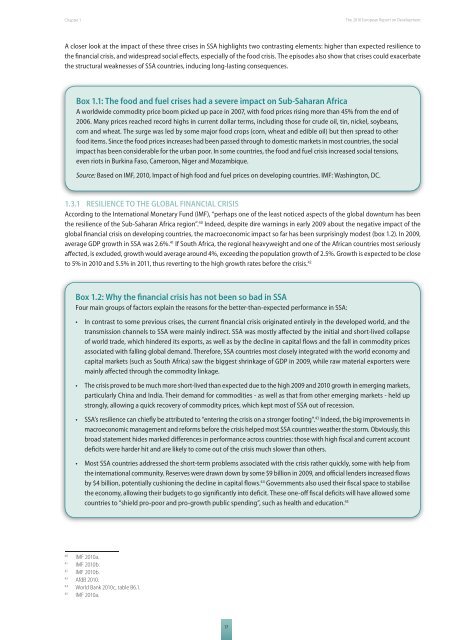social protection for inclusive development - European Report on ...
social protection for inclusive development - European Report on ...
social protection for inclusive development - European Report on ...
You also want an ePaper? Increase the reach of your titles
YUMPU automatically turns print PDFs into web optimized ePapers that Google loves.
Chapter 1<br />
The 2010 <str<strong>on</strong>g>European</str<strong>on</strong>g> <str<strong>on</strong>g>Report</str<strong>on</strong>g> <strong>on</strong> Development<br />
A closer look at the impact of these three crises in SSA highlights two c<strong>on</strong>trasting elements: higher than expected resilience to<br />
the financial crisis, and widespread <str<strong>on</strong>g>social</str<strong>on</strong>g> effects, especially of the food crisis. The episodes also show that crises could exacerbate<br />
the structural weaknesses of SSA countries, inducing l<strong>on</strong>g-lasting c<strong>on</strong>sequences.<br />
Box 1.1: The food and fuel crises had a severe impact <strong>on</strong> Sub-Saharan Africa<br />
A worldwide commodity price boom picked up pace in 2007, with food prices rising more than 45% from the end of<br />
2006. Many prices reached record highs in current dollar terms, including those <str<strong>on</strong>g>for</str<strong>on</strong>g> crude oil, tin, nickel, soybeans,<br />
corn and wheat. The surge was led by some major food crops (corn, wheat and edible oil) but then spread to other<br />
food items. Since the food prices increases had been passed through to domestic markets in most countries, the <str<strong>on</strong>g>social</str<strong>on</strong>g><br />
impact has been c<strong>on</strong>siderable <str<strong>on</strong>g>for</str<strong>on</strong>g> the urban poor. In some countries, the food and fuel crisis increased <str<strong>on</strong>g>social</str<strong>on</strong>g> tensi<strong>on</strong>s,<br />
even riots in Burkina Faso, Camero<strong>on</strong>, Niger and Mozambique.<br />
Source: Based <strong>on</strong> IMF, 2010, Impact of high food and fuel prices <strong>on</strong> developing countries. IMF: Washingt<strong>on</strong>, DC.<br />
1.3.1 RESILIENCE TO THE GLOBAL FINANCIAL CRISIS<br />
According to the Internati<strong>on</strong>al M<strong>on</strong>etary Fund (IMF), “perhaps <strong>on</strong>e of the least noticed aspects of the global downturn has been<br />
the resilience of the Sub-Saharan Africa regi<strong>on</strong>”. 40 Indeed, despite dire warnings in early 2009 about the negative impact of the<br />
global financial crisis <strong>on</strong> developing countries, the macroec<strong>on</strong>omic impact so far has been surprisingly modest (box 1.2). In 2009,<br />
average GDP growth in SSA was 2.6%. 41 If South Africa, the regi<strong>on</strong>al heavyweight and <strong>on</strong>e of the African countries most seriously<br />
affected, is excluded, growth would average around 4%, exceeding the populati<strong>on</strong> growth of 2.5%. Growth is expected to be close<br />
to 5% in 2010 and 5.5% in 2011, thus reverting to the high growth rates be<str<strong>on</strong>g>for</str<strong>on</strong>g>e the crisis. 42<br />
Box 1.2: Why the financial crisis has not been so bad in SSA<br />
Four main groups of factors explain the reas<strong>on</strong>s <str<strong>on</strong>g>for</str<strong>on</strong>g> the better-than-expected per<str<strong>on</strong>g>for</str<strong>on</strong>g>mance in SSA:<br />
• In c<strong>on</strong>trast to some previous crises, the current financial crisis originated entirely in the developed world, and the<br />
transmissi<strong>on</strong> channels to SSA were mainly indirect. SSA was mostly affected by the initial and short-lived collapse<br />
of world trade, which hindered its exports, as well as by the decline in capital flows and the fall in commodity prices<br />
associated with falling global demand. There<str<strong>on</strong>g>for</str<strong>on</strong>g>e, SSA countries most closely integrated with the world ec<strong>on</strong>omy and<br />
capital markets (such as South Africa) saw the biggest shrinkage of GDP in 2009, while raw material exporters were<br />
mainly affected through the commodity linkage.<br />
• The crisis proved to be much more short-lived than expected due to the high 2009 and 2010 growth in emerging markets,<br />
particularly China and India. Their demand <str<strong>on</strong>g>for</str<strong>on</strong>g> commodities - as well as that from other emerging markets - held up<br />
str<strong>on</strong>gly, allowing a quick recovery of commodity prices, which kept most of SSA out of recessi<strong>on</strong>.<br />
• SSA’s resilience can chiefly be attributed to “entering the crisis <strong>on</strong> a str<strong>on</strong>ger footing”. 43 Indeed, the big improvements in<br />
macroec<strong>on</strong>omic management and re<str<strong>on</strong>g>for</str<strong>on</strong>g>ms be<str<strong>on</strong>g>for</str<strong>on</strong>g>e the crisis helped most SSA countries weather the storm. Obviously, this<br />
broad statement hides marked differences in per<str<strong>on</strong>g>for</str<strong>on</strong>g>mance across countries: those with high fiscal and current account<br />
deficits were harder hit and are likely to come out of the crisis much slower than others.<br />
• Most SSA countries addressed the short-term problems associated with the crisis rather quickly, some with help from<br />
the internati<strong>on</strong>al community. Reserves were drawn down by some $9 billi<strong>on</strong> in 2009, and official lenders increased flows<br />
by $4 billi<strong>on</strong>, potentially cushi<strong>on</strong>ing the decline in capital flows. 44 Governments also used their fiscal space to stabilise<br />
the ec<strong>on</strong>omy, allowing their budgets to go significantly into deficit. These <strong>on</strong>e-off fiscal deficits will have allowed some<br />
countries to “shield pro-poor and pro-growth public spending”, such as health and educati<strong>on</strong>. 45<br />
40<br />
IMF 2010a.<br />
41<br />
IMF 2010b.<br />
42<br />
IMF 2010b.<br />
43<br />
AfdB 2010.<br />
44<br />
World Bank 2010c, table B6.1.<br />
45<br />
IMF 2010a.<br />
17
















